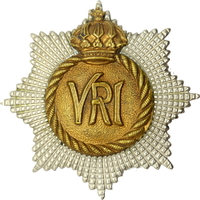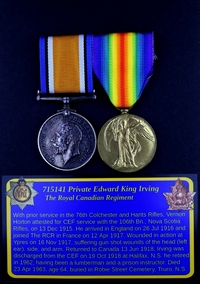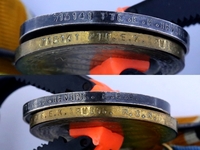
715141 Private Edward Kay Irving
The Royal Canadian Regiment
By: Capt (ret'd) Michael M. O'Leary, CD, The RCR
Edward Kay Irving was born in Mount Thom, Pictou County, Nova Scotia, on 5 Jan 1897 (according to his First World War attestation paper). Irving's family, led by parents John and Anna (Annie), can be found in the 1901 and 1911 Canadian Censuses. The two appearances of the family, although there are not uncommon differences in the recording and transcription of names, including the spelling of their surname as Irvin. The 1901 Census shows the family with ten children between the ages of 21 and 2. Curiously, Edward, who should be four years old in 1901, isn't listed. The youngest child listed in 1901 is James, born in January 1899. By the time of the 1911, five children are still at home and Edward, identified as born in January 1899, is now shown among them. Alternate names used by Irving provided by ancestry.ca include "Edward King Irving" and "James Edward Irving."
Irving attested for service in the Canadian Expeditionary Force (C.E.F.) with the 106th Overseas Battalion at Truro, Nova Scotia, on 13 Dec 1915. An 18-year-old blacksmith, Irving was described on his attestation paper as 5 feet 10 inches tall, weighing 150 pounds, with a 37 1/4-inch chest, a fair complexion, good physical development, brown eyes, and brown hair. His religious denomination was Presbyterian. Irving identified his Mother, "Annie Wall," as his next of kin. Having declared prior service with the 76th Regiment, Colchester and Hants Regiment, on attesting with the 106th Battalion, Irving was given the regimental number 715141.
The 106th Battalion (Nova Scotia Rifles), was based in Truro, Nova Scotia, with two companies in Pictou and Springhill. The unit began recruiting on 18 Nov 1915. During the 106th Battalion's training period, Irving would twice be admitted to hospital. His first hospital stay at Truro, N.S., was for tonsillitis from 1 Mar 1916. He was discharged to duty on 15 Mar 1916. Two months later, on 4 May 1916, Irving was back in hospital. He was admitted to the Willow St. Hospital at Truro, N.S, suffering from diptheria and would be discharged back to his unit on 14 May 1916.
The 106th Battalion sailed for England on 15 Jul 1916 aboard the S.S. Empress of Britain, arriving at Liverpool, England, on 25 Jul 1916, and continuing their training at Lower Dibgate, Shorncliffe. The battalion was soon absorbed into the reinforcement system, and most of its soldiers transferred to the 40th Battalion (Nova Scotia), C.E.F.
Irving's transfer to the 40th Res. Bn. at Caesar's Camp occurred on 5 Oct 1916. He would return to hospital on 1 Jan 1917 at Dibgate, diagnosed with influenza. Irving spent a week in hospital before being discharged to duty. A few days later, having spent two months with the 40th Res. Bn., Irving was transferred on 4 Jan 1917 to the 26th Canadian Reserve Battalion (Nova Scotia).
After more than seven months in England, Irving "proceeded overseas" on 4 Mar 1917. He crossed the Channel to land in France and reported at the Canadian Base Depot on 5 Mar 1917. Concurrent with his arrival in France, he was taken on the strength of The Royal Canadian Regiment.
Irving remained at the Base Depot until 26 Mar 1917 when he was sent forward to the 3rd Entrenching Battalion, arriving at the unit on 30 Apr. This Divisional troops unit was employed as a ready labour force and by design its troops were a forward reserve of reinforcements for the division's fighting battalions. They were also used as labour forces to maintain and build trenches or other work as needed.
While some troops might find their stay with the Entrenching Battalion lasting months before they were called forward to join their designated units as a reinforcement, for Irving the wait was only two weeks duration. On 12 Apr 1917, days after the Canadian Corps assault on Vimy Ridge, Irving joined The RCR at Villers Camp. He was one of a reinforcement draft of 168 soldiers sent to replace losses during the Vimy Ridge operation.
Although Irving arrived at the unit too late for the Vimy Ridge assault, the summer of 1917 would provide his baptism of fire. The cycle of front line trenches, support trenches, reserves, marching, and training which were the perpetual cycle of the infantry battalion on the Western Front was Irving's wartime experience throughout the summer and fall of 1917. Few tours of the front lines were without casualties, and even when out of the most forward trenches, the reach of enemy artillery could take its toll. In this period, the Regiment earned its Battle Honours for "Hill 70," "Ypres, 1917," and "Passchendaele."
Irving's front line service, however, would come to a painful end after the Regiment's return to the Ypres sector in November. Edward Irving was wounded in action near Ypres on 16 Nov 1917. The Regiment's War Diary describes recorded the following:
"16-11-17. – YPRES Sector.
"Heavy retaliatory enemy barrage 6.50 a.m. to 8.00 a.m. Brig-general COFFIN of the relieving Brigade and four Officers of the 2nd Lincolns called at 10.00 a.m. to arrange the relief. Major H.M. LOGAN and C.S.M. REVEIL wounded during heavy enemy barrage, which continued all day on the support lines with little relaxation. Major STEWART of the P.P.C.L.I. called during the afternoon.
"Capt. C.G.B. THOMPSON to Hospital.
Lieut. H. SYKES and Lieut. F.L. FOSTER invalided to Eng.
5 O.R's from C.C.S.
2 O.R's from C.B.D.
2 O.R's to C.C.S.
On 16 Nov 1917, Irving was one of the two other ranks admitted to the Casualty Clearing Station. The same day, he was transferred to No. 9 Canadian Field Ambulance suffering from gun shot wounds [G.S.W.] of the head (left ear), side, and arm. In the medical terminology of the Great War, gun shot wounds could refer to wounds made by bullets, shrapnel, or shell splinters. Moving steadily rearward in the medical evacuation system, Irving was admitted to No. 2 Australian General Hospital on 23 Nov 1917. he would remain here only three days before being evacuated, wounded, from France to England aboard the hospital ship H.S. Jan Breydel on 26 Nov 1917.
Once in England, Irving was struck off the strength of The RCR and posted to the Nova Scotia Regimental Depot (N.S.R.D.). The N.S.R.D. was part of the new regionally based reinforcement system, with named Depots taking in troops from battalions raised in those areas in Canada and providing reinforcement drafts to similarly designated fighting units. The RCR, having been headquartered in Halifax in the decade before the War, was associated with the N.S.R.D. These Depots also became the parent unit for any soldiers returned to England from their affiliated battalions in France and Flanders.
Irving was admitted to the 2nd Birmingham War Hospital on 27 Nov 1917. He would remain here for 88 days undergoing surgery and treatment. Irving was transferred on 22 Feb 1918 to the Duchess of Connaught Canadian Red Cross Hospital at Taplow, Buckinghamshire. He would stay at this hospital a further 102 days before being recommended for transfer to Canada.
A report prepared on 8 Mar 1918 for a Standing Medical Board described Irving's condition. The report noted partial loss of function of his left arm and left leg due to gun shot wounds caused by a shell explosion at Passchendaele on 16 Nov 1917. His present condition was noted as "scar eight inches long left loin extending over iliac crest. In centre of scar is sinus 2" deep which extends into ilium. Wound is healthy and granulating well, also is scar over posterior upper arm attached to deeper structures about function of muscles and upper thirds. Scar about size of half crown. Is considerable wasting in muscles of hand and forearm. Trophic changes in skin. All movements present but impaired." The recommendation to the Board for Irving was "Invalid to Canada." Standing Medical Board, convened at Duchess of Connaught Canadian Red Cross Hospital, Taplow, Buckinghamshire, on 14 Mar 1918 confirmed this recommendation.
A Last Pay Certificate prepared in order to close out Irving's pay account overseas was completed on 30 Mar 1918. This certificate showed that Irving was returning to Canada with an outstanding balance of $429.68. At $1.10 per day, pay and field allowance, this represented well over a year of accumulated pay.
Irving sailed for Canada aboard the hospital ship H.S. Neuralia Concurrent with sailing from England, he was taken on the strength of No. 6 District Depot, Halifax, on 3 Jun 1918. The following day he was posted to the Depot's Hospital Section in preparation for his arrival in Canada on 13 Jun 1918.
After a few weeks with the Depot's Hospital Section, Edward Irving was admitted to Camp Hill Hospital in Halifax on 29 Jun 1918. His admission record notes "wounds healed — unable to pick an article off floor without bending knees on account of scar dragging. Arm loss of some triceps substance. Very slight loss of power, Category E." Men placed in category "E" were those not likely to become fit within six months.
On 27 Sep 1918, a Medical History of an Invalid form was completed at Halifax to summarize Irving's medical condition at that time. His present disability was described as "impaired function of muscles of back." The notes on the form repeat the difficulties Irving has with bending over far enough to pick objects up from the floor. A diagram shows the area of scarring and lost muscle mass extending from his left side at waist level around to the lower spine. His wound, which had been discharging fluid throughout his convalescence, had only ceased to do so four weeks before the report was completed. An operation at Camp Hill Hospital to remove necrosed bone from his ilium (hip bone) had been performed on 9 Jul 1918. The medical history report confirmed a category of "E" and also stated that Irving would not be able to resume his prior occupation as a blacksmith.
A Case History Sheet was completed on Irving at Camp Hill Hospital, Halifax, on 12 Oct 1918, the day he was discharged from that facility. The report described his condition as: "Fairly well nourished man who complains of soreness and weakness in back and side after a half mile walk. Struck in left side with piece of shell fragment (16 Nov 1917) causing injury to ilium and resulting in discharging wound. At present horizontal scar about 6" in length and just over the crest of the ilium on the left side. Scar is somewhat adherent and tender on manipulation. In the centre there is a discharging sinus running down to ilium." On discharge from Camp Hill, Irving was posted from the District Depot's Hospital Section to the Casualty Company in preparation for discharge.
Medically unfit for further service, Edward Irving was discharged from the C.E.F. on 19 Oct 1918 at Halifax, N.S. His conduct and character while in the service was noted as "Very Good." He was authorized to wear "one gold bar," i.e., a wound stripe, which would go on the lower left sleeve of his uniform. It is unlikely that he would ever wear the wound stripe, since his Discharge Certificate was stamped a warning: "Uniform not to be worn after Date of Discharge unless written authority has been granted by G.O.C. [General Officer Commanding] of District." Irving stated that his intended place of residence after release was Riversdale, Nova Scotia.
Irving's Last Pay Certificate, completed to close his pay account on his discharge date, shows that he was paid his daily rate of pay ($1.00 per day) and his field allowance (10 cents per day) up to the 19th of October. He also received $35.00 clothing allowance. Although Irving's service record is missing the applicable page of his pay records, he would also have been entitled to a War Service Gratuity.
For his service in the C.E.F., Irving was entitled to receive the British War Medal and the Victory Medal. These were despatched to him at Riversdale, N.S., on 24 Nov 1922.
Back at home after the war, Irving appears in the 1921 Canadian Census. This document establishes why his mother's surname was given as "Wall" on his C.E.F. attestation form. His mother is shown as married to William Wall, a second marriage that must have happened between the 1911 census and Irving's enlistment in 1915. Irving is shown in 1921 as 22 years of age, confirming his birth year as 1899. Also at home still is younger brother Wilfred (19).
When Edward Irving enlisted for service with the C.E.F., he declared his birth year to be 1897 and his age 18. The 1901 Census, however, shows son "James," which matches one of the aliases for Irving recorded on ancestry.ca, born in January 1899. The latter birth year is corroborated by Irving's age recorded in the 1921 census and that shown on his gravestone. These establish that when Edward Irving enlisted in Dec 1915, it was one month before his 17th birthday.
Irving retired from civilian employment in 1962, having been employed as a lumberman and as a prison instructor. He died at the age of 64 on 23 Apr 1963 at Hilden, Colchester County, N.S. The cause of death was recorded as coronary thrombosis. Edward Irving is buried in Robie Street Cemetery, Truro, N.S., with a soldier's gravestone noting his unit as "106 Batt'n, C.E.F."
Irving was survived by his widow, Mrs. Isabelle Irving. She would live another 26 years, until 1987.
Pro Patria
Visit a randomly selected page in The O'Leary Collection (or reload for another choice):
- The O'Leary Collection; Medals of The Royal Canadian Regiment.
- Researching Canadian Soldiers of the First World War
- Researching The Royal Canadian Regiment
- The RCR in the First World War
- Badges of The RCR
- The Senior Subaltern
- The Minute Book (blog)
- Rogue Papers
- Tactical Primers
- The Regimental Library
- Battle Honours
- Perpetuation of the CEF
- A Miscellany
- Quotes
- The Frontenac Times
- Site Map
QUICK LINKS
The O'Leary Collection—Medals of The Royal Canadian Regiment
Newest additions:
![]()
![]() SB-12725 Private Henry "Hank" Ard
SB-12725 Private Henry "Hank" Ard ![]()
WIA at Hill 187, Died of Wounds in Japan
![]()
![]() 2355331 Lance Corporal Albert Lorking
2355331 Lance Corporal Albert Lorking
Wounded in action, later a War Amps representative.
![]()
![]() 4334 / 477996 Pte Isaac Hamilton Wilcox
4334 / 477996 Pte Isaac Hamilton Wilcox
Permanent Force, South Africa, and C.E.F.
![]()
![]() 477019 Private Harold Ashcroft
477019 Private Harold Ashcroft
Transferred to the Tunnelers.
![]()
![]() 734231 Private Clark D. Thompson
734231 Private Clark D. Thompson ![]()
The older Thompson brother, killed in action.
![]()
![]() 733849 Private Norman Parker Thompson
733849 Private Norman Parker Thompson
The younger Thompson brother; post-war service in the Special Guard.
![]()
![]()
![]() A305 / 400305 Private Andrew Walker
A305 / 400305 Private Andrew Walker ![]()
"Previously reported Wounded, now Killed in Action."
![]()
![]() 823298 Pte Thomas Patrick Steele, M.M.
823298 Pte Thomas Patrick Steele, M.M. ![]()
… for gallant conduct in the field …
![]()
![]() P13066 Sergeant Harold Thompson
P13066 Sergeant Harold Thompson
Instrumental Soloist for over 20 years of Canadian Army service.
![]()
![]() 9609 / 477728 Private Albert Edward Piper
9609 / 477728 Private Albert Edward Piper
"Arrived from England as a STOWAWAY …"



